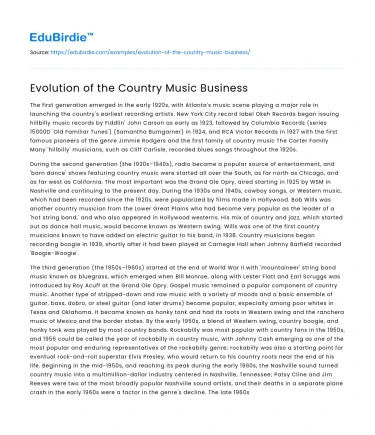The first generation emerged in the early 1920s, with Atlanta's music scene playing a major role in launching the country's earliest recording artists. New York City record label Okeh Records began issuing hillbilly music records by Fiddlin' John Carson as early as 1923, followed by Columbia Records (series 15000D 'Old Familiar Tunes') (Samantha Bumgarner) in 1924, and RCA Victor Records in 1927 with the first famous pioneers of the genre Jimmie Rodgers and the first family of country music The Carter Family Many 'hillbilly' musicians, such as Cliff Carlisle, recorded blues songs throughout the 1920s.
During the second generation (the 1930s–1940s), radio became a popular source of entertainment, and 'barn dance' shows featuring country music were started all over the South, as far north as Chicago, and as far west as California. The most important was the Grand Ole Opry, aired starting in 1925 by WSM in Nashville and continuing to the present day. During the 1930s and 1940s, cowboy songs, or Western music, which had been recorded since the 1920s, were popularized by films made in Hollywood. Bob Wills was another country musician from the Lower Great Plains who had become very popular as the leader of a 'hot string band,' and who also appeared in Hollywood westerns. His mix of country and jazz, which started out as dance hall music, would become known as Western swing. Wills was one of the first country musicians known to have added an electric guitar to his band, in 1938. Country musicians began recording boogie in 1939, shortly after it had been played at Carnegie Hall when Johnny Barfield recorded 'Boogie-Woogie'.
Save your time!
We can take care of your essay
- Proper editing and formatting
- Free revision, title page, and bibliography
- Flexible prices and money-back guarantee
The third generation (the 1950s–1960s) started at the end of World War II with 'mountaineer' string band music known as bluegrass, which emerged when Bill Monroe, along with Lester Flatt and Earl Scruggs was introduced by Roy Acuff at the Grand Ole Opry. Gospel music remained a popular component of country music. Another type of stripped-down and raw music with a variety of moods and a basic ensemble of guitar, bass, dobro, or steel guitar (and later drums) became popular, especially among poor whites in Texas and Oklahoma. It became known as honky tonk and had its roots in Western swing and the ranchera music of Mexico and the border states. By the early 1950s, a blend of Western swing, country boogie, and honky tonk was played by most country bands. Rockabilly was most popular with country fans in the 1950s, and 1956 could be called the year of rockabilly in country music, with Johnny Cash emerging as one of the most popular and enduring representatives of the rockabilly genre; rockabilly was also a starting point for eventual rock-and-roll superstar Elvis Presley, who would return to his country roots near the end of his life. Beginning in the mid-1950s, and reaching its peak during the early 1960s, the Nashville sound turned country music into a multimillion-dollar industry centered in Nashville, Tennessee; Patsy Cline and Jim Reeves were two of the most broadly popular Nashville sound artists, and their deaths in a separate plane crash in the early 1960s were a factor in the genre's decline. The late 1960s in American music produced a unique blend as a result of traditionalist backlash within separate genres. In the aftermath of the British Invasion, many desired a return to the 'old values' of rock n' roll. At the same time, there was a lack of enthusiasm in the country sector for Nashville-produced music. What resulted was a crossbred genre known as country rock.
Fourth generation (the 1970s–1980s) music included outlaw country with roots in the Bakersfield sound, and country pops with roots in the countrypolitan, folk music, and soft rock. Between 1972 and 1975 singer/guitarist John Denver released a series of hugely successful songs blending country and folk-rock musical styles. During the early 1980s country, artists continued to see their records perform well on the pop charts. In 1980 a style of 'neocountry disco music' was popularized. During the mid-1980s a group of new artists began to emerge who rejected the more polished country-pop sound that had been prominent on radio and the charts in favor of more traditional 'back-to-basics' production; this neotraditional movement would dominate country music through the late 1980s and be typified by the likes of George Strait. Attempts to combine punk and country were pioneered by Jason and the Scorchers, and in the 1980s Southern Californian cowpunk scene with bands like the Long Ryders and Mojo Nixon.
During the fifth generation (the 1990s), country music became a worldwide phenomenon. Two types of artists enjoyed mainstream popularity: neo-traditionalists such as Alan Jackson, and the more broadly popular stadium country acts, in particular Garth Brooks. The Dixie Chicks became one of the most popular country bands in the 1990s and early 2000s.
The sixth generation (the 2000s–present) has seen a certain amount of diversification in regard to country music styles. The influence of rock music in the country has become more overt during the late 2000s and early 2010s. Most of the best-selling country songs of this era were in the country pop genre, such as those by Lady Antebellum, Florida Georgia Line, Carrie Underwood, and Taylor Swift.






 Stuck on your essay?
Stuck on your essay?

